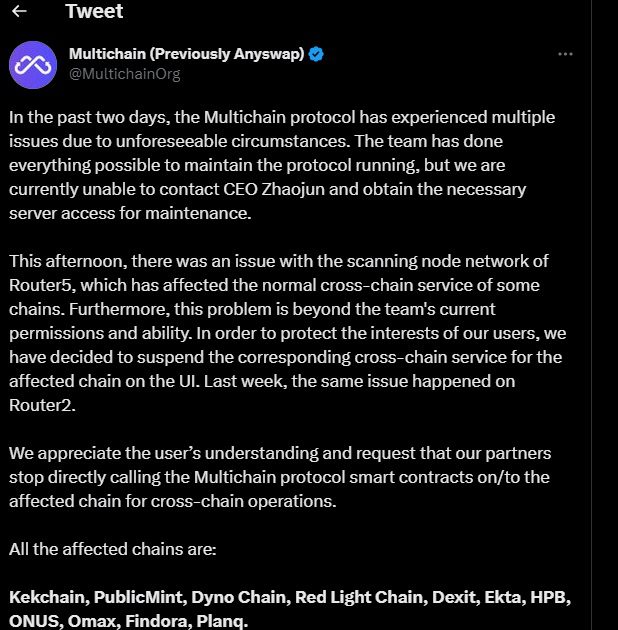Quick take:
- Multichain has halted cross-chain operations citing unforeseen circumstances.
- The bridging protocol said on Wednesday it had tried to contact its CEO Zhaojun without success.
- The AWOL chief holds key information that grants permissions to cross-chain servers.
Multichain’s CEO has gone missing according to the company’s statement on Wednesday. The cross-chain bridging protocol said for the past two days it has been experiencing issues in its cross-chain bridges due to unforeseen circumstances.
The company’s attempt to contact its chief failed leading to the decision to halt cross-chain bridging operations. Zhaojun holds key information required for granting permissions to the cross-bridge servers.
“In the past two days, the Multichain protocol has experienced multiple issues due to unforeseeable circumstances,” the company’s Twitter account posted. “The team has done everything possible to maintain the protocol running, but we are currently unable to contact CEO Zhaojun and obtain the necessary server access for maintenance.”
With the servers offline, Multichain could not keep cross-bridge protocols to Kekchain, PublicMint, Dyno Chain, Red Light Chain, Dexit, Ekta, HPB, ONUS, Omax, Findora and Planq running.


This disclosure comes following days of rumours that access to Multichain servers had been constricted, confirming speculations that at least one member with access keys to the servers had gone missing.
According to Coindesk, the problem first arose last week, and the publisher’s attempts to contact Zhaojun have gone without reply.
However, Fireblocks’ Head of Security Products Shahar Madar presents two possible outcomes moving forward.
In a comment sent to NFTgators, Madar said: “I believe this situation is just another example of the trauma throughout the ecosystem from everything that has happened, such as UST and FTX. Multichain was trusted by many, and the fact that they disappeared is legitimately worrying.”
According to Madar, if an arrest has been made of the Multichain team, it could be followed by what he calls a “shake operation”, “where the Multichain team will be held until the consent of the regime’s will is established. “
Alternatively, if the parties are found to have breached Chinese laws, then a legitimate law enforcement process is started.
While the second case is straightforward, the first one is a little complicated and could have far-reaching effects on the future of Multichain.
According to Madar, “If the Chinese authorities have decided to intervene in the bridge’s operations, its future will depend on the security foundations that the founders have set, alongside their willingness to cooperate.”
The web3 security expert cites the Chinese government’s historic influence on developments in the local technology and financial sectors. However, he also points out that the situation could be different when it comes to Multichain.
“China has a history of interventions in tech and financial industries, but for an on-chain project, their options are limited – as China obviously isn’t after stealing the bridge’s money or all of the data that is publicly available on-chain,” says Madar.
Furthermore, China’s recent decision to embrace web3 could also influence how it proceeds with Multichain’s case.
“It is possible that China wants Multichain to be more aligned with its agenda and give, for example, the authorities the ability to control transactions that go through the bridge or balances that the bridge holds.”
But this could also have more serious ramifications for Multichain users. “If the system was built in a way that allows them to do so (e.g. enough of the keys controlling the wallet are held by the arrested parties) – they could force them to make a copy, essentially creating a “backdoor” for the regime to change the bridge’s state whenever they want,” Madar added.
And for the users, it is unfortunate that they will never find out about this until the first exploit happens, he said.
****
Stay up to date:
Subscribe to our newsletter using this link – we won’t spam!




